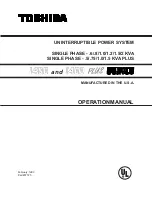
6
1.
RS-232 communication port
2.
USB communication port
3.
Emergency power off function connector (EPO connector)
4.
Share current port (only available for parallel model)
5.
Parallel port (only available for parallel model)
6.
Intelligent slot
7.
Cooling fan
8.
External maintenance bypass switch port
9.
Maintenance bypass switch
10.
Input circuit breaker
11.
Output receptacles: connect to mission-critical loads
12.
Output circuit breaker for receptacles
13.
Input/Output terminal (Refer to Diagram 2, 4, 6 for the details)
14.
Output terminal: connect to mission-critical loads
15.
Programmable output terminal: connect to non-critical loads
16.
External battery connector
17.
Utility input terminal
2-3. Single UPS Installation
Installation and wiring must be performed in accordance with the local electric laws/regulations and execute
the following instructions by professional personnel.
1)
Make sure the mains wire and breakers in the building are enough for the rated capacity of UPS to
avoid the hazards of electric shock or fire.
NOTE:
Do not use the wall receptacle as the input power source for the UPS, as its rated current is less than
the UPS’s maximum input current. Otherwise the receptacle may be burned and destroyed.
2)
Switch off the mains switch in the building before installation.
3)
Turn off all the connected devices before connecting to the UPS.
4)
Prepare wires based on the following table:
Model
Wiring spec (mm
2
)
Input
Output
Battery
Ground
6k
10
10
10
6kL
10
10
10
10
10k
16
16
16
10kL
16
16
16
16
NOTE 1:
The cable for 6k/6kL should be able to withstand over 40A current. It is recommended to use
10 mm
2
or thicker wire for safety and efficiency.
NOTE 2:
The cable for 10k/10kL should be able to withstand over 63A current. It is recommended to
use 16mm
2
or thicker wire for safety and efficiency.
NOTE 3:
The selections for color of wires should be followed by the local electrical laws and








































